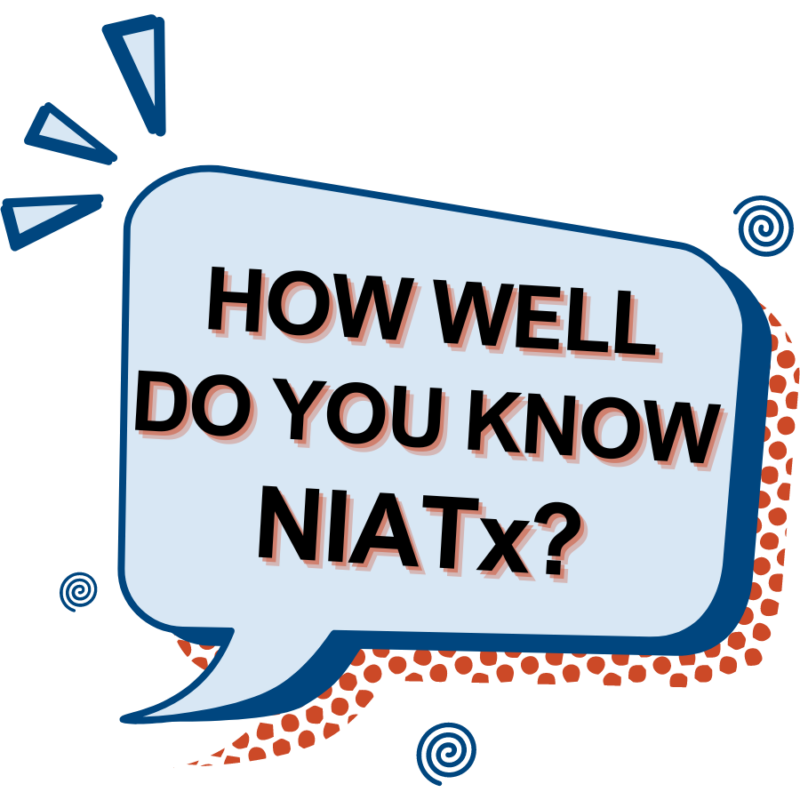Home > The ATTC/NIATx Service Improvement Blog > Quiz: How Well Do You Know NIATx?
Whether you're a seasoned NIATx expert or just beginning your NIATx journey, we have a challenge for you. Take this quick quiz to find out just how well you know this evidence-based process improvement approach!

Question 1:What does NIATx stand for?
A) The Network for Improvement and Technical Excellence
B) The Network for the Integration of Accelerated Treatment Systems
C) The Network for the Improvement of Addiction Treatment
D) The National Institute for Addiction Treatment Excellence
Answer: C: The Network for the Improvement of Addiction Treatment. The original NIATx projects launched in 2003 focused on helping substance abuse treatment organizations improve their treatment admissions and continuation processes. These projects were so successful that NIATx expanded into other human services areas: mental health, child welfare services, and the criminal justice system, to name just a few. Since then, the model has been widely known by the acronym "NYE-ah-tex,” with the accent on the first syllable.
Question 2:Which of the following is a key principle of the NIATx model?
A) Long-term strategic planning
B) Understand and involve the customer
C) Minimal interaction with stakeholders
D) Maintain the status quo
Answer: B: Understand and involve the customer, which is one of the five key NIATx principles. NIATx developer David H. Gustafson and team conducted a study of successful improvement projects, gathering data from 640 organizations in 13 industries, looking at 80 factors. Only five factors emerged as significant in successful projects. Of these five factors, "Understand and involve the customer" had more influence on the success of a project than all the other factors put together.
Question 3:True or False: NIATx focuses only on improving organizational processes in SUD treatment organizations, such as intake and assessment, treatment planning, and service delivery.
Answer: False: The NIATx model can be used to improve any process in any organization.
Question 4 What is the primary goal of using rapid-cycle testing in NIATx?
A) To delay implementation of improvements
B) To make gradual changes over several years
C) To test and implement changes quickly
D) To discourage innovation
Answer: C: To test and implement changes quickly. Rapid-cycle testing is structured around using Plan-Do-Study-Act (PDSA) Cycles. It allows a change team to quickly test a change, measure it, and then adopt, adapt, or abandon it based on the results. Rapid-cycle testing accelerates the overall process and makes it easy to adapt to unexpected outcomes. Plus, quick results help keep team members engaged.
Question 5: Which NIATx tool is used to understand a process from start to finish?
A) SWOT analysis
B) PDSA cycles
C) Flowcharting
D) Gap analysis
Answer: Flowcharting. In the NIATx model, teams use flowcharting to represent each step in a process visually. This helps identify duplication and bottlenecks that can reduce productivity, create inconsistency, and have a negative impact on the customer experience.
Question 6:True or False: Sustainability is a key component of the NIATx approach.
True: NIATx change projects include a plan for maintaining the gain. This includes naming a team member the "sustain manager," who is responsible for ensuring that changes are documented, maintained, and integrated into the organization's everyday practices.
Question 7 Which of the following is a common challenge when implementing a NIATx change project?
A) Resistance to change
B) The change project drifts off course.
C) Data collection is inconsistent.
D) All of the above
Answer: D: All of the above. When change teams encounter these challenges, it’s important to reconvene. Showcasing early successes to demonstrate the positive impact of the change can help overcome resistance to change. If the project drifts off course, going back to the original project plan and goals can help refocus the team. When data collection is haphazard, create clear yet simple protocols for data collection to ensure consistency.
8. What is the NIATx tool used for brainstorming?
A) Plan-Do-Study-Act
B) Fishbowl Technique
C) Nominal Group Technique
D) The Five Whys
Answer: Nominal Group Technique (NGT). This technique uses silent idea generation, round-robin sharing, and recording of ideas. Group participants vote or rank ideas anonymously to prioritize them based on predefined criteria. The final step involves reaching a consensus on the most promising ideas or solutions. A moderator or facilitator guides the NGT process.
9. What makes the NIATx approach unique as a process improvement model?
A) It requires teams to conduct a walk-through exercise.
B) It emphasizes simplicity and rapid change.
C) It is based on five evidence-based principles.
D) All of the above.
Answer: D: All of the Above. NIATx change projects begin with teams conducting a walk-through to experience a process from the customer's perspective. NIATx was specifically created for behavioral health organizations to be easy to learn and implement, emphasize rapid change, and be backed by the science on organizational change.
Question 10:Which of the following service areas have used NIATx to make improvements?
A) Suicide prevention programs in schools
B) Culturally and linguistically appropriate services
C) Substance use prevention
D) All of the above
Answer: D: NIATx is used successfully in all areas listed.
Scoring Your NIATx Quiz
0-3 correct answers: Novice: Keep exploring NIATx principles to enhance your understanding.
4-6 correct answers: Apprentice: You have a solid grasp of NIATx fundamentals.
7-9 correct answers: Practitioner: Your knowledge of NIATx is commendable!
10 correct answers: Change Leader: Congratulations! You are a NIATx expert.
How did you score on our NIATx quiz? Whether you're new to NIATx or a seasoned practitioner, understanding the NIATx approach and tools can transform how your organization makes and sustains changes.
Share your results and challenge your colleagues to take the quiz, too!
The opinions expressed herein are the views of the authors and do not reflect the official position of the Department of Health and Human Services (DHHS), SAMHSA, CSAT or the ATTC Network. No official support or endorsement of DHHS, SAMHSA, or CSAT for the opinions of authors presented in this e-publication is intended or should be inferred.